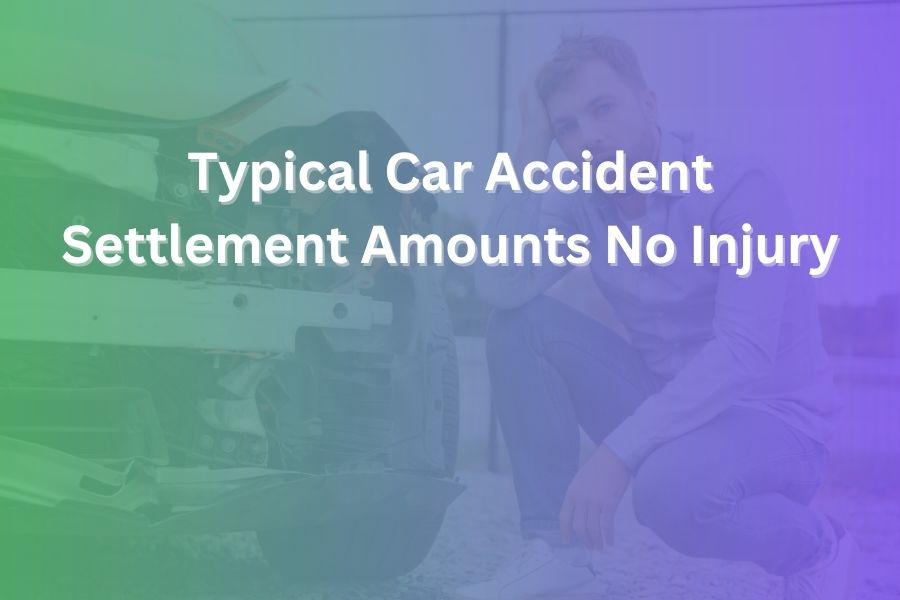When you are involved in a car accident and walk away with no physical injuries, it might feel like your case is straightforward. But in reality, obtaining a fair settlement for a no-injury crash requires understanding how insurers value property damage, diminished vehicle value, rental costs, and other non-injury factors.
In this article you will learn how much you can reasonably expect from a settlement when there are no bodily injuries, what factors influence that number, and how to protect your rights through the process.
Understanding No-Injury Car Accident Settlements
A no-injury car accident settlement occurs when you are involved in a motor vehicle crash, someone else is at fault (or liability is established), and your claim does not include medical treatment for injuries. Instead, the settlement focuses on property damage, rental costs, diminished value of your vehicle, and other non-bodily losses. Because you did not require medical treatment, the value of your claim will generally be much lower than cases involving injury.
Even though you were not injured, the insurer and at-fault party still owe you compensation for verifiable loss: repair bills, diminished resale value, car rental, tow and storage fees, and possibly inconvenience. These form the core of your claim. Accepting an offer without understanding your losses and rights may leave you under-compensated.
What Are Typical Settlement Amounts When No Injury Occurs?
While every case is unique, you can use guidance from recent data to form realistic expectations.
- One source indicates that for no-injury car accidents the average settlement range falls somewhere between $20,000 and $25,000, based on 2020 publicly available survey information.
- Some other data suggests that typical “minor injury or no treatment” settlements often land in the $10,000-$15,000 range.
- In jurisdictions like Illinois, when no injuries or only very minor ones exist the range can drop further, to about $2,500 to $10,000.
- For property damage only (no injury), estimates show typical amounts of $3,000 or less in some regions, though that is for less serious damage.
Therefore, if you were in a crash, suffered no physical injury, and only your vehicle was impacted, a reasonable ball-park settlement might lie somewhere between $5,000 and $25,000 depending on damage severity, diminished value, and other losses.
Why Is There Such a Broad Range?
Several key factors influence how much your settlement may be in a no-injury accident. Understanding them can help you maximize your outcome.
- Extent of Property Damage
The more significant the vehicle damage, the higher the settlement. A minor bumper scrape will result in a much smaller payout than a total loss or extensive frame damage. The repair cost is a strong starting point for valuation. - Diminished Vehicle Value
Even after full repairs, a car involved in a crash often loses resale value. If your vehicle is “marked” as having been in an accident, you may negotiate for that lost value. Some insurers will factor in diminished value claims. - Rental, Tow, Storage Costs
If you needed a rental car during repairs, or incurred tow/storage fees because your car was immobilised, those costs add to your claim. Make sure you have documentation of all incurred expenses. - Liability and Insurance Coverage
It matters whether the at-fault party is clearly responsible and has sufficient insurance. If liability is disputed or the at-fault driver has minimal coverage, your settlement may be reduced or delayed. Also, your own policy may include underinsured motorist or property damage coverages that affect your recovery. - State Laws and Insurance Minimums
The legal environment of your state influences outcomes. Minimum required insurance limits vary by state and may cap what an insurer will pay. In no‐fault states, the rules about suing and recovering may also differ. - Your Own Actions and Documentation
How you document damage, gather estimates, track rental and transportation expenses, and communicate with insurers matters. Prompt reporting, accurate records, and credible estimates strengthen your position; delays or missing documentation weaken it.
How to Estimate Your No-Injury Settlement Value
Here’s a simple approach you can use to approximate what your settlement might be:
- Step 1: Gather all your actual costs (repair estimate or total loss value, rental car cost, tow/storage cost).
- Step 2: Check your vehicle’s diminished value (you may need an independent appraiser if your insurer doesn’t provide one).
- Step 3: Confirm the at-fault driver’s insurance coverage and whether your own policy comes into play (for example, collision deductible, rental reimbursement, underinsured motorist property damage).
- Step 4: Factor in a buffer for negotiation (insurers usually offer less than top value, so leave room for discussion).
- Step 5: If needed, consider small amounts for inconvenience or loss of use (though with no injury this is modest).
What You Should Not Expect
- You should not expect large awards for pain and suffering, loss of enjoyment of life, or future medical costs, since there is no injury requiring treatment.
- You should not assume the “average settlement” for injury cases applies to you. Cases with injuries routinely settle for tens of thousands or more because medical and non-economic losses matter.
- You should not accept the first offer without checking your losses and negotiating; insurers know no-injury claims typically command less and may try to minimize your payout accordingly.
Steps to Protect and Maximize Your Settlement
Follow these practical tips to strengthen your case:
- Report the accident immediately to both your insurer and the at-fault driver’s insurer. Delays may weaken your claim.
- Photograph the damage, scene, and repair estimates. Get multiple repair shop quotes if possible.
- Document your rental, tow and storage expenses with receipts and logs.
- If your vehicle is a total loss, research actual fair market value before accepting the insurer’s offer.
- Consult your own insurance policy – you may have rental reimbursement or diminished value coverage that applies.
- Avoid signing any releases too early. Wait until all property damage is known (including diminished value).
- If liability is disputed or the at-fault driver’s coverage is limited, consider consulting an attorney to evaluate options.
- Keep copies of every communication and ensure that any offer covers all your documented losses.
When Is Legal Assistance Worth While?
Even in no-injury accident cases, legal assistance can make a difference in certain situations:
- If your vehicle sustained major structural damage or total loss, and you’re seeking diminished value recovery.
- If liability is contested or the at-fault driver lacks sufficient insurance.
- If your insurer or the other party’s insurer is refusing to cover reasonable rental or storage costs.
- If your losses are substantial (for example, over $10,000) and you want to maximize your settlement rather than accept a quick lowball offer.
A lawyer experienced with property-damage only claims can review whether you are being offered the full fair value and handle negotiations or litigation if required.
Realistic Timeline and What to Expect
In a no-injury car accident claim, you may expect:
- Initial settlement offer within a few weeks if fault is clear and damage is minor.
- If major damage or total loss, negotiation may take several months to complete as repair/valuation, rental reimbursement and diminished value are resolved.
- You may receive a check once you sign a release and agreed upon amount, which could be 30-90 days after agreement is reached.
- Avoid rushing. If you accept too early, you may forfeit the right to claim rental reimbursement or diminished value once the full scope is known.
Conclusion
If you’re involved in a car accident with no bodily injuries, your claim still counts and you deserve a fair settlement. The value will generally be much lower than injury claims, often ranging from a few thousand dollars to tens of thousands depending on damage severity, diminished value, rental costs, and insurance. By documenting all your losses, understanding how insurers value these claims, and not rushing into a premature settlement, you can maximize your recovery.
Treat your no-injury accident claim with as much care as you would an injury claim—because the difference between accepting the first offer and negotiating properly could be several thousand dollars.




